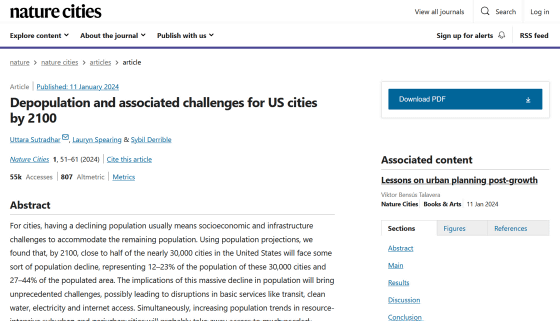Researchers warn that about half of American cities may become ghost towns by 2100

Modern society is exposed to sea level rise and climate change due to global warming, and at the time of writing, cities where many people live do not necessarily survive into the 22nd century. A study predicting population changes in American cities finds that by 2100, half of the nation's roughly 30,000 cities could face some form of population decline, losing 12 to 23 percent of their population. Did.
Depopulation and associated challenges for US cities by 2100 | Nature Cities

Thousands of US Cities Could Become Virtual Ghost Towns by 2100 | Scientific American
https://www.scientificamerican.com/article/thousands-of-us-cities-could-become-virtual-ghost-towns-by-2100/
Thousands of US Cities Could Verge on Becoming Ghost Towns by 2100, Study Finds : ScienceAlert
https://www.sciencealert.com/thousands-of-us-cities-could-verge-on-becoming-ghost-towns-by-2100-study-finds
A research team led by Sybil Delible , a professor in the Department of Civil, Materials, and Environmental Engineering at the University of Illinois at Chicago in the United States, originally investigated how the urban population of Illinois changes over time, and the resulting traffic problems. He said that he was working on the problem of what the problem was. However, he realized that such predictions would be useful outside of Illinois, so he expanded the scope of his research to cover the entire United States.
'Most studies focus on large cities, but that doesn't help estimate the scale of the problem,' said Uttra Stradahl, a graduate student in civil engineering at the University of Illinois at Chicago and lead author of the paper. 'I can't.'
The research team analyzed data collected by the U.S. Census and the National Community Survey from 2000 to 2020 to identify current population trends in more than 24,000 cities and predict the future of nearly 32,000 cities. We modeled population projections. They also applied the trends predicted by the model to five future climate scenarios and investigated how the urban population would change under each scenario.

The analysis found that of the 24,000 cities that identified current population changes, 43% are gradually losing residents and are in decline. On the other hand, approximately 40% of cities, including major cities such as New York,
However, by 2100, the population of about half of America's cities, including Cleveland , Ohio, Buffalo , New York, and Pittsburgh , Pennsylvania, was predicted to decline by 12 to 23 percent.
By region, the Northeast and Midwest are expected to be most affected by depopulation, with Vermont and West Virginia in particular expected to see more than 80% of their cities shrink. In addition, approximately three-quarters of cities in Illinois, Mississippi, Kansas, New Hampshire, and Michigan may experience population declines. On the other hand, the places most likely to see population growth by 2100 were located in the south or west.
This study did not investigate the factors that will determine future urban population. However, Stradahl said a complex interplay of regional variables such as rising house prices, industrial decline, declining birth rates, differences in state taxes, and the effects of climate change could result in population declines or increases. Masu.

Depopulation in future cities is not likely to result in all people disappearing from the city all at once, but rather it is likely that divided communities will spread out in a chaotic manner. If local governments and urban planners fail to respond to the progress of depopulation, various infrastructures may be adversely affected.
In some cities, the negative effects of the loss of people are already becoming apparent. In Jackson , Mississippi's capital, water treatment facilities were damaged by the 2022 floods, leaving the state without safe tap water for more than a week. Black people make up more than 70% of Jackson's population, and it has been pointed out that this situation was caused by the decline in tax revenue due to the departure of white people and the inability to repair water facilities.
The research team warned: ``Significant population declines pose unprecedented challenges, potentially disrupting basic services such as transport, clean water, electricity, and internet access.'' did.
◆Forum now open
A forum related to this article has been set up on the GIGAZINE official Discord server . Anyone can write freely, so please feel free to comment! If you do not have a Discord account, please create one by referring to the article explaining how to create an account!
• Discord | 'Is the population of the area where you live increasing or decreasing?' | GIGAZINE
https://discord.com/channels/1037961069903216680/1211613067851472896
Related Posts:
in Science, Posted by log1h_ik







